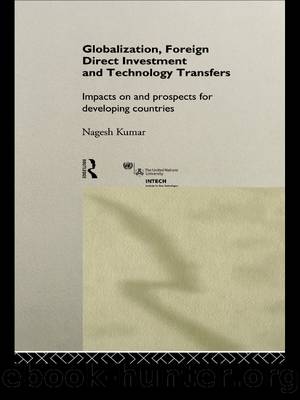Globalization, Foreign Direct Investment and Technology Transfers: Impacts on and Prospects for Developing Countries by Nagesh Kumar

Author:Nagesh Kumar [Kumar, Nagesh]
Language: eng
Format: epub
Tags: Political Science, General
ISBN: 9780203193624
Google: ZStQngEACAAJ
Goodreads: 16460769
Publisher: Routledge
Published: 1998-10-01T00:00:00+00:00
Conclusions
German MNEs have raised their share of global FDI outflows during the first half of this decade. The strongest growth in German FDI has been recorded in Central and Eastern Europe. Markets, geographical proximity, low labour costs, privatization, preferential trading arrangements and cultural relations have facilitated the involvement of German MNEs in this region.
From the perspective of developing countries, it is relevant to note that the growth of German FDI in Central and Eastern Europe has occurred not at their expense, although the possibility of investment diversion in some highly labour intensive industries cannot be completely ruled out. One apparent indication of the absence of investment diversion is that German FDI in developing countries has increased parallel to that in Central and Eastern Europe. Moreover, a diversion of German FDI is unlikely because most of it in developing countries is location-bound. Only a minor proportion of German FDI is in labour intensive branches of textiles, leather and clothing, which can be mobile between different locations. The data for Central and Eastern European countries indicate that these industries have hosted so far very small ratios of FDI inflows.
A recent survey of German MNEs recorded penetration and preservation of markets as their most important motive for investing in Central and Eastern Europe. Low wage costs and relocation of production to improve competitiveness figured at third and fifth places, respectively.
The growth of German FDI in Central and Eastern Europe does not appear to be at the expense of domestic capital formation either; but one can indeed see that many Bavarian firms have located production units in the neighbouring border areas of the Czech Republic. The local authorities of some of the regions in eastern Bavaria are worried about job losses. But for the German economy as a whole, FDI outflows have recorded declining ratios of gross fixed capital formation.
German and other European FDI is expected to rise more than proportionately in CEE. About 16 per cent of the US and Japanese stocks of FDI are invested in Latin America and Asia, respectively. Germany has so far only 2 per cent and the European Union 1 per cent of its FDI stock located in CEE. Judging on the basis of the US and Japanese geographical pattern, and of favourable prospects of growing market size in this region, German and other European MNEs can be expected to further increase their activities in CEE. The emergence of CEECs as hosts for German MNEs has indeed increased locational competition for developing countries. But this is not expected to retard the growth of German FDI in developing countries provided their absorptive capacity based on income growth, infrastructure and macroeconomic stability continues to grow.
Download
This site does not store any files on its server. We only index and link to content provided by other sites. Please contact the content providers to delete copyright contents if any and email us, we'll remove relevant links or contents immediately.
The Brazilian Economy since the Great Financial Crisis of 20072008 by Philip Arestis Carolina Troncoso Baltar & Daniela Magalhães Prates(105765)
International Integration of the Brazilian Economy by Elias C. Grivoyannis(75561)
The Art of Coaching by Elena Aguilar(52203)
Flexible Working by Dale Gemma;(23213)
How to Stop Living Paycheck to Paycheck by Avery Breyer(19570)
The Acquirer's Multiple: How the Billionaire Contrarians of Deep Value Beat the Market by Tobias Carlisle(12114)
Thinking, Fast and Slow by Kahneman Daniel(11802)
The Radium Girls by Kate Moore(11631)
The Art of Thinking Clearly by Rolf Dobelli(9929)
Hit Refresh by Satya Nadella(8863)
The Compound Effect by Darren Hardy(8523)
Atomic Habits: Tiny Changes, Remarkable Results by James Clear(8054)
Tools of Titans by Timothy Ferriss(7824)
Turbulence by E. J. Noyes(7712)
Change Your Questions, Change Your Life by Marilee Adams(7384)
A Court of Wings and Ruin by Sarah J. Maas(7275)
Nudge - Improving Decisions about Health, Wealth, and Happiness by Thaler Sunstein(7259)
How to Be a Bawse: A Guide to Conquering Life by Lilly Singh(7162)
Win Bigly by Scott Adams(6832)
